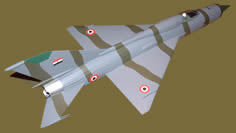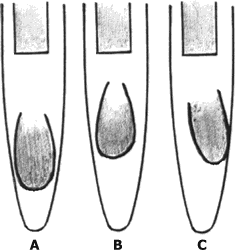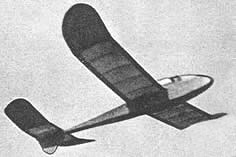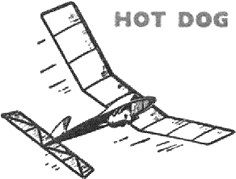|
|
|
|||
|
|
||||
|
|
||||
| The Smoky Addiction | ||||
|
|
HOME | SITE MAP | FORUM | CONTACT |
|
||
|
ABOUT | MOTORS | MODELS | ARCHIVE | HISTORY | STORE | FAQ | LINKS
|
|
|
|
|
|
|||||||||||||||||||||||||||||||||||||||||||||||||||||||||
|
The Smoky Addiction 5
(May 2005)
by Roger Simmonds Reprinted from SAM 35 Speaks, May 2005 Steve Bage has now finished his twin-engined Yak 25 [below right]. As reported in the March’s edition of the SA, Steve’s earlier profile prototype flew so well he had every expectation a more complex model would not disappoint. He writes: “It was such a nice day here in Aberdeen that I took a half-day holiday and gave the Yak its first flight. I'm amazed to say that it flies better than I ever hoped. It glided straight, right off the board, but I added a little tail weight to flatten the glide a bit. The first powered flight showed a slight stall (should not have added the weight!) but it still gained a good deal of height before the motors expired. I removed the tail weight and gave it another go, and this time it climbed away straight as an arrow … straight in fact, too straight in fact, as it flew out of the field and into an adjacent marsh …. I found it eventually after yomping though the bog [this must be an activity peculiar to Aberdeen] … It had come to rest in a big gorse bush, fortunately the only damage was a slight ding in the leading edge and a couple of minor punctures in the tissue. I gave it another two flights, managing a consistent and gentle left turn on the final flight. All four flights were of longer duration than anything I've achieved before with my other Rapier models, so to say I'm pleased is an understatement. The Yak is also very stable, which leads me to think that scale anhedral could have been built in without adverse effect, but I'll leave that to someone else to try. I even managed all four flights without wasting a single Rapier from ignition failure! The only tricky aspect of the flight performance was that it proved difficult to trim for a consistent turn. This is most likely due to the variations in the thrust of the motors resulting in a turn first one way, then the other. The glide is as straight as a die when the engines quit. It's obviously a model for big fields!” |
 Steve Bage’s built-up Yak 25 twin for L2
- Steve Bage
|
|||||||||||||||||||||||||||||||||||||||||||||||||||||||||
|
|
|
|||||
|
Steve’s productivity matches his modelling skills. He has just finished a MiG 21 [right], for which, curiously, there appears to have been no period plan, and designed a British ‘might have been’, the Hawker P1121, also for L2. I hope Steve will now turn his attention to some classic Jetex models, and to encourage him to return to our roots I have sent him plans for the Skyleada Hunter and the YF-100. Steve is also expert in CAD, and has corrected the distortions I found in the Hunter plan. The MiG 21 will probably fly in a spectacular fashion – it weighs 29 g and it glides straight and very fast – if, (and it is a big if, see later) a high enough rated L2HP can be found for it. Apropos of which, I have been having more motor trouble recently, and the L2s I bought in the autumn proved very disappointing, so I was interested that Steve didn’t appear to be having problems. I asked him which batches he was using. He replied, “The L2 Rapiers came from Mike Woodhouse a couple of weeks ago and are rated at 110 mN. I too had problems with the last batch of L2HPs (which were again from Mike). These were hardly enough to keep my Sukhoi SU-11 airborne, and then only if I trimmed it for dead straight flight. Previous L2HPs had it looping, so there is something wrong for sure. I might try these under-performing motors in the Yak.” My last batch of L2HPs didn’t provide enough thrust to keep my normally oh-so-reliable Fairey Delta 2 in the air. Not wishing to waste motors, I tried them in my DH 108 Swallow, which can fly very nicely with an 85 mN L2LT. Alas, I was let down not only by their low power, but also their off-centre orifices – the asymmetric thrust deflecting off the trough caused unexpected turns (in either direction) and several hard arrivals. The exhaust created different deposits in the trough, a phenomenon also noted by Andy Blackwell. |

- Steve Bage
|
|||||
|
Andy Blackwell’s Flitzer has an asbestos trough, not the usual foil, and deposits left by the exhausts of L2s from different batches show up as grey patterns of various shapes and sizes. These can be correlated with flight patterns [see right]: A: Steep climb with an interesting ‘tail slide’, in the middle. B: Nice steady flight with climb to height and wide stable turn. C: Unplanned turn to the right with ‘motor on’ arrival. The conclusions are: (a) grossly distorted motors should be discarded; (b) if the asymmetry is not too pronounced the motor should be rotated in the tube so that its nozzle is aligned, as far as possible, with the centre of the trough. I would therefore advise Steve to look very carefully at his batch of L2HPs, and if in doubt, not to risk his beautiful model. Derek Knight, too, told me he has several batches of duff motors he doesn’t know what to do with (they might make good fertiliser) as has Howard Metcalfe. Asymmetric thrust can have an even more disastrous influence on the flight performance of troughless free flight duration designs. Ben Nead writes: “This year we were snookered by [fellow competitors using] old Jetex motors due to Rapier nozzles not being concentric with the casings, and thrustlines could not be duplicated in any two flights. This is a serious problem for Rapiers because it introduces another set of parameters. Also the variation of thrust from one batch to another imposes another set of almost insurmountable obstacles to competition. Though Rapiers are a great little product they are still immature and better uniformity is very much needed.” Now all this is most distressing, reminiscent as it is of the difficulties experienced with Powermax Jet-X products. Duff motors are not only model breakers, they will also put off many potential recruits to our noble addiction. I’m not sure what the answer is. Jan Zigmund has a monopoly and can obviously sell all that he cares to produce, but one rather hopes he will introduce better quality control to match his expanding production and that Rapiers will regain their previously good reputation. Would any supplier care to comment on the current frustrating situation? Mind you, what with damaged gaskets and worn springs, Jetex motors were not entirely free of these sorts of problems. For the angle of thrustline to be a major factor in trimming (see Dick Twomey, Aeromodeller, October 1951) it had to be reproducible; C R De Vries advised contest fliers to always put the motor in its mount with the same orientation (AM, June 1953), an implicit acknowledgement of possible inaccuracies in motor casings. |
 Rapier L2 trough deposits
- Andy Blackwell
|
|||||
|
Twomey’s 28" span model for Jetex 200, was called, you will remember, the Twizzler [right]. It was by all accounts no turkey (sorry!). With its underslung fin and high mounted motor it is most suitable for Rapier power, though achieving a consistent thrustline could be difficult in present circumstances. The design is interim between his Firecrest and the later Stiletto, which takes some of the Twizzler’s features, for example the high thrustline and streamlining, to their logical conclusion (Model Aircraft, May 1954). The Twizzler, though, looks more robust, and if reduced to about 16-17" would make a lovely period model for Rapier L2. [Ed.: Jetex.org has the plan and Twomey's contruction notes.] |

- Aeromodeller, Oct. 1951
|
|||||
|
Staying with classic duration designs, Australian reader Darien Cassidy requested a plan for the Hot Dog, Ian Dowsett’s Wilmot Mansour kit for the newly introduced Jetex 50 [below right]. Darien’s colleague Mike Hardy cleaned up my plan (which was very poor) and produced the very nice model on the right. According to Darrien, ‘Jetex type’ flying is only possible “when the grass is green” so I am still awaiting a flight report. It is amazing what can be done these days using the various computer packages now available, and I look forward to seeing what Mike has made of the Hot Dog plan, which was an Nth generation photocopy (N being a large number!). It’s not only plans that can be cleaned up. Christian Bryan specialises in box top artwork, and his restoration of the rather battered box
This month’s offering is, I’m afraid, rather meagre, as I have been busy with preparations for the Jetex/FROG Exhibition at Solent Sky. I hope to produce a compilation of all the (Jet)X Files, (these have been reformatted with extra illustrations), which will be autographed by our distinguished guests. This manuscript will then be turned into a professionally produced book similar in size, weight, (and price) to a SAM 35 Yearbook. Distribution of this unique souvenir of an historic event is by subscription, so if you would like a copy please let me know. |

- Mike Hardy

- Wilmot Mansour advertisement
|
|||||
|
|
||||||
|
|
|
|||||
|
|
|
|
|
|
|
|
Acknowledgements - Article: Roger Simmonds - Illustrations: Roger Simmonds, Steve Bage, Andy Blackwell, Christian Bryan, Mike Hardy, MAAC archives via Bill Henderson |
|
|
|
|
ABOUT | MOTORS | MODELS | ARCHIVE | HISTORY | STORE | FAQ | LINKS |
|
|
Terms of Use
|
Queries? Corrections? Additions?
Please
contact us.
|
|